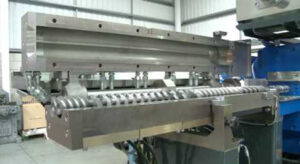Useful tips for the production of TPE on twin-screw compounder
Paul Andersen, Coperion
The process for compounding thermoplastic elastomer formulations is comprised of multiple unit operations. These typically include, but are not limited to, feedstock introduction, polymer/ polymer or polymer/filler melt-mixing, distributive/dispersive downstream mixing of oil extenders/minerals/additives, removal of volatiles, and pressurization for die discharge. While each unit operation has an impact on process productivity and quality of the finished product, melt mixing and downstream feeding/filler incorporation have a significantly greater impact than the others in TPE compounding processes.
To design the optimal screw configuration for polymer melting, one needs to address more than the kneading block sequence in the melting section. First, key physical and viscosity characteristics need to be identified. One of the most important parameters is the enthalpy curve. This will provide guidance related to the energy required to melt and compound the polymer, as illustrated in figure 1, an enthalpy curve for a crystalline type polymer, such as polypropylene.

